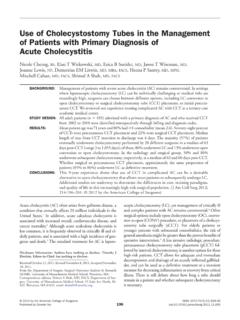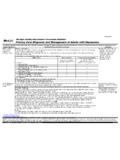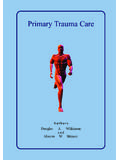Transcription of Management of Medial Collateral Ligament Injury …
1 Joint Implant Surgery & Research FoundationReconstructive ReviewVolume 4, Number 2, June 2014 Management of Medial Collateral Ligament Injury During Primary Total KneeArthroplasty: A Systematic ReviewDr. Paul Kenneth Della Torre, BSc, MBBS ; Dr. Andrew Stephens, BAppSc, MBBS ; Dr. Horng Lii Oh, GC-SpMed, MBBS ; Dr. Akshay Kamra, MBBS ; Dr. Bernard Zicat, BSc, MD, CM, FRACS (Orth), FAOrthA ; Dr. Peter Walker, MBBS, FRACS (Orth), FAOrthA ORIGINAL ARTICLE Department of Orthopaedic Surgery, Concord Hospital, Hospital Road, NSW, 2139 AustraliaAbstractMedial Collateral Ligament Injury during primary total knee arthroplasty is a recognised complication potentially resulting in valgus instability, suboptimal patient outcomes and a higher rate of revision or re-operation.
2 Options for Management include primary repair with or without augmentation, reconstruction or immediate conversion to prosthesis with greater constraint, in conjunction with various postoperative rehabilitation protocols. Inconsistent recommendations throughout the orthopaedic literature have made the approach to managing this complication problematic. The objective of this study was to review the available literature to date comparing intraoperative and postoperative Management options for prima-ry total knee arthroplasty complicated by recognised Injury to the Medial Collateral Ligament .
3 This sys-tematic literature review was prospectively registered with PROSPERO (#CRD42014008866) and per-formed in accordance with PRISMA guidelines including a PRISMA flow diagram. Five articles satisfied the inclusion criteria. Each was a retrospective, observational cohort or case series with small numbers reported, inconsistent methodology and incompletely reported outcomes. Four of the five studies man-aging Medial Collateral Ligament Injury during total knee arthroplasty (47/84 patients) with direct repair with or without autograft augmentation reported good outcomes with no revision or reoperation required for symptomatic instability over a follow-up period of 16 months to almost 8 years.
4 The fifth study with a follow-up to 10 years and a high rate of conversion to unlinked semi constrained total knee arthroplasty implant (30/37 patients) reported a greater incidence of revision due to instability, in patients in whom the Medial Collateral Ligament Injury was directly repaired without added constraint. Overall balance of evi-dence is in favour of satisfactory outcomes without symptomatic instability following direct repair with or without augmentation of an Medial Collateral Ligament Injury recognised intraoperatively during total knee arthroplasty. An implant with greater constraint may have reduced longevity in younger, more ac-tive patients through aseptic loosening.
5 In elderly or less mobile patients, and in situations where the me-dial Collateral Ligament repair is deemed poor quality or incomplete, an implant with greater constraint would seem prudent. In patients where direct repair with or without augmentation was used, a period of 4-6 weeks of unrestricted rehabilitation in a hinged knee brace should be 2014, JISRF. All rights reserved. DOI: gives permission for reproduction of articles as long as notification and recognition is provided. 18 JISRF Reconstructive Review Vol. 4, No. 2, June 2014 Joint Implant Surgery & Research Foundation disruption to the Medial Collateral liga-ment (MCL) during total knee arthroplasty (TKA) is an un-common but recognised complication reported in of TKAs [1-5].
6 Failure to achieve long term coronal plane stability in a primary TKA may significantly influence out-comes by shortening an implant s longevity through accel-erated wear, negatively affecting patient satisfaction and functional scores and ultimately leading to reoperation or early Collateral Ligament Injury during TKA is gener-ally considered to be an iatrogenic complication [3]. Mor-bid obesity has been considered a risk factor contributing to intraoperative avulsion of the tibial insertion of the MCL during difficult exposure [4]. No consensus has been reached on the ideal manage-ment of recognised MCL Injury during primary TKA, with options considered intraoperatively such as primary repair, immediate reconstruction or changing the implant to in-crease constraint.
7 Primary repair can be attempted by di-rect suture apposition of a midsubstance MCL laceration, anchor or screw with post fixation of an avulsed MCL in-sertion, or fixation of the avulsed insertion through a tran-sosseous bridge [2]. Augmentation of a repaired MCL has also been described with semitendinosus tendon [6] or quadriceps tendon free graft in cases with a residual gap after repair, poor quality tissue or if there was suspicion of the repair stretching postoperatively [7]. Coronal plane instability has been shown in cadaveric studies to be significantly affected by release of the deep and superficial components of the MCL [8].
8 Conversion of a posterior cruciate sparing implant to a posterior stabi-lised component in this study after release of the MCL and posterior cruciate Ligament (PCL), did not provide any sig-nificant restraint to valgus laxity. Unlinked varus-valgus constrained prostheses have been advocated for the treat-ment of intraoperative disruption of the MCL and resul-tant valgus laxity [9-11]. There is reluctance, particular-ly in young active patients to using implants with greater constraint due to increased stresses transferred to the im-plant-cement and implant-bone interfaces, osteolysis, ac-celerated polyethylene wear and risk of subsequent aseptic loosening [12].
9 Furthermore, there is no agreement as to the ideal post-operative Management of patients following MCL repair with or without augmentation, reconstruction or conver-sion to implants with additional constraint. Casting, pro-vision of hinged bracing, degrees of freedom in bracing, weightbearing status and duration of postoperative treat-ment of each method are aim of this systematic literature review was to com-pare predetermined patient outcomes following repair or reconstruction of recognised MCL Injury during primary TKA to cases where additional constraint was used as part of the Management of valgus laxity over at least 12 months from time of index operation.
10 MethodsThe review protocol for this systematic review was registered with the International Prospective Register of Systematic Reviews (PROSPERO: ) #CRD42014008866 prior to screen-ing articles against eligibility study was designed to identify in the literature, pa-tients of any age undergoing primary total TKA who sus-tain a recognised intraoperative Injury to the MCL. Prima-ry repair with or without augmentation or reconstruction of the injured MCL by any means was compared to intraop-erative increase in constraint, to a prosthesis with unlinked high polyethylene post on tibial insert or linked hinged prosthesis, with concurrent repair or reconstruction of the MCL.





